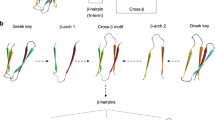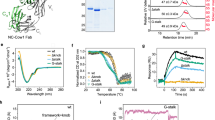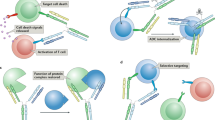Abstract
The development of abzymes (antibody/enzymes) is one method of creating reagents with novel catalytic activity. To date, most abzymes have been obtained by immunization with transition state analogs. We have chosen to start with an existing antibody and convert it into an enzyme by the addition of catalytic residues to the binding site. We have introduced a histidine residue into antibody Jel 103 and converted it into an abzyme that cleaves poly(rI) with a kinetic efficiency of about 100 M–1sec–1.
This is a preview of subscription content, access via your institution
Access options
Subscribe to this journal
Receive 12 print issues and online access
$209.00 per year
only $17.42 per issue
Buy this article
- Purchase on Springer Link
- Instant access to full article PDF
Prices may be subject to local taxes which are calculated during checkout





Similar content being viewed by others
References
Tramontano, A., Janda, K.D., and Lerner, R.A. 1986. Catalytic antibodies. Science 234: 1566–1570.
Pollack, S.J., Jacobs, J.W., and Schultz, P.G. 1986. Selective chemical catalysis by an antibody. Science 234: 1570– 1573.
Raso, V. and Stollar, B.D. 1975. The antibody enzyme analogy: comparison of enzymes and antibodies specific for phosphopyridoxyltyrosine. Biochemistry 14: 591–599.
Schultz, P.G. and Lerner, R.A. 1995. From molecular diversity to catalysis: lessons from the immune system. Science 269: 1835–1842.
Kirby, A.J. 1996. Enzyme mechanisms, models, and mimics. Angew. Chem. Int. Ed. Engl. 35: 707– 724.
Kirby, A.J. 1996. The potential of catalytic antibodies. Acta. Chem. Scand. 50: 203–210.
Shuster, A.M., Golobov, G.V., Kvashuk, O.A., Bogomolova, A.E., Smirnov, I.V., and Gabibov, A.G. 1992. DNA-hydrolyzing autoantibodies. Science 256: 665–667.
Paul, S., Volle, D.J., Beach, C.M., Johnson, D.R., Powell, M.J., and Massey, R.J. 1989. Catalytic hydrolysis of vasoactive intestinal peptide by human autoantibody. Science 244: 1158–1162.
Stewart, J.D. and Benkovic, S.J. 1995. Transition-state stabilization as a measure of the efficiency of antibody catalysis. Nature 375: 388–391.
Pokkuluri, P.R., Bouthillier, F., Li, Y., Kuderova, A., Lee, J., and Cygler, M. 1994. Preparation, characterization and crystallization of an antibody fab fragment that recognizes RNA. J. Mol. Biol. 243: 283–297.
Kuderova, A., Tanha, J., and Lee, J.S. 1994. Characterization of four nucleic acid-binding single-chain Fv fragments by direct and competitive solid-phase radioimmunoassays. J. Biol. Chem. 269: 32957– 32962.
Breslow, R., Huang, D.L., and Anslyn, E. 1989. On the mechanism of action of ribonucleases: dinucleotide cleavage catalyzed by imidazole and Zn2+. Proc. Natl. Acad. Sci. USA 86: 1746–1750.
Gohda, K., Oka, K.-I., Tomita, K.-I., and Hakoshima, T. 1994. Crystal structure of RNase T1 complexed with the product nucleotide 3'-GMP. J. Biol. Chem. 269: 17531–17536.
Baldwin, E. and Schultz, P.G. 1989. Generation of a catalytic antibody by site-directed mutagenesis. Science 245: 1104–1107.
Heyduk, T. and Lee, J.C. 1990. Application of fluorescence energy transfer and polarization to monitor Escherichia coli cAMP receptor protein and lac promoter interaction. Proc. Natl. Acad. Sci. USA 87: 1744– 1748.
LeTilly, V. and Royer, C.A. 1993. Fluorescence anisotropy assays implicate protein-protein interactions in regulating trp repressor DNA binding. Biochemistry 32: 7753–7758.
Bird, R.E., Hardman, K.D., Jacobson, J.W., Johnson, S., Kaufman, B.M., Lee, S.-M. et al. 1988. Single-chain antigen binding proteins. Science 242: 423– 426.
Glockshuber, R., Malia, M., Pfitzinger, I., and Plückthun, A. 1990. A comparison of strategies to stabilize immunoglobulin Fv-Fragments. Biochemistry 29: 1362–1367.
Barry, M.M. and Lee, J.S. 1993. Cloning and expression of an autoimmune DNA-binding single chain Fv. Only the heavy chain is required for binding. Mol. Immunol. 30: 833–840.
Jia, Z., Quail, J.W., Waygood, E.B., and Delbaere, L.T.J. 1987. The 2.0-Å resolution structure of Escherichia coli histidine-containing phosphocarrier protein HPr. J. Biol. Chem. 268: 22490–22501.
Prasad, L., Vandonselaar, M., Lee, J.S., and Delbaere, L.T.J. 1988. Structure determination of a monoclonal fab fragment specific for histidine-containing protein of the phosphoenolpyruvate: sugar phosphotransferase system of Escherichia coli. J. Biol. Chem. 263: 2571–2574.
Herron, J.N., He, X-H., Ballard, D.W., Blier, P.R., Pace, P.E., Bothwell, A.L.M. et al. 1991. An autoantibody to single-stranded DNA: comparison of the three-dimensional structures of the unliganded Fab and a deoxynucleotide-Fab complex. Proteins: Struct. Funct. Genet. 11: 159– 175.
Morgan, A.R., Lee, J.S., Pulleyblank, D.E., Murray, N.L., and Evans, D.H. 1979. Ethidium fluorescence assays. Nucleic Acids Res. 7: 547–569.
Walz, F.G., Osterman, H.L., and Libertin, C. 1979. Base-group specificity at the primary recognition site of ribonuclease T1 for minimal RNA substrates. Arch. Biochem. Biophys. 195: 95–102.
Mossakowska, D.E., Nyberg, K., and Fersht, A.R. 1989. Kinetic characterization of the recombinant ribonuclease from Bacillus amyloliquefaciens (Barnase) and investigation of key residues in catalysis by site-directed mutagenesis. Biochemistry 28: 3843– 3850.
Quéméneur, E., Moutiez, M., Charbonnier, J-B., and Ménez, A. 1998. Engineering cyclophilin into a proline-specific endopeptidase. Nature 391: 301– 303.
Braun, R.P., Woodsworth, M.L., and Lee, J.S. 1986. The immunogenic properties of poly(dI).poly(dC) and poly(rI).poly(dC). Analysis of monoclonal antibodies. Mol. Immunol. 23: 685– 691.
Tanha, J. and Lee, J.S. 1997. Thermodynamic analysis of monoclonal antibody binding to duplex DNA. Nucl. Acids Res. 25: 1442–1449.
Acknowledgements
This work was funded by Medical Research Council by grants to J.S.L. and by Health Services Utilization and Research Commission for fellowships for M.C.F. and A.K.
Author information
Authors and Affiliations
Additional information
Department of Biochemistry, University of Saskatchewan, Saskatoon, Saskatchewan, Canada S7N 5E5.
Rights and permissions
About this article
Cite this article
Fletcher, M., Kuderova, A., Cygler, M. et al. Creation of a ribonuclease abzyme through site-directed mutagenesis. Nat Biotechnol 16, 1065–1067 (1998). https://doi.org/10.1038/3519
Received:
Accepted:
Issue Date:
DOI: https://doi.org/10.1038/3519
This article is cited by
-
Design of a serine protease-like catalytic triad on an antibody light chain displayed on the yeast cell surface
Applied Microbiology and Biotechnology (2007)



